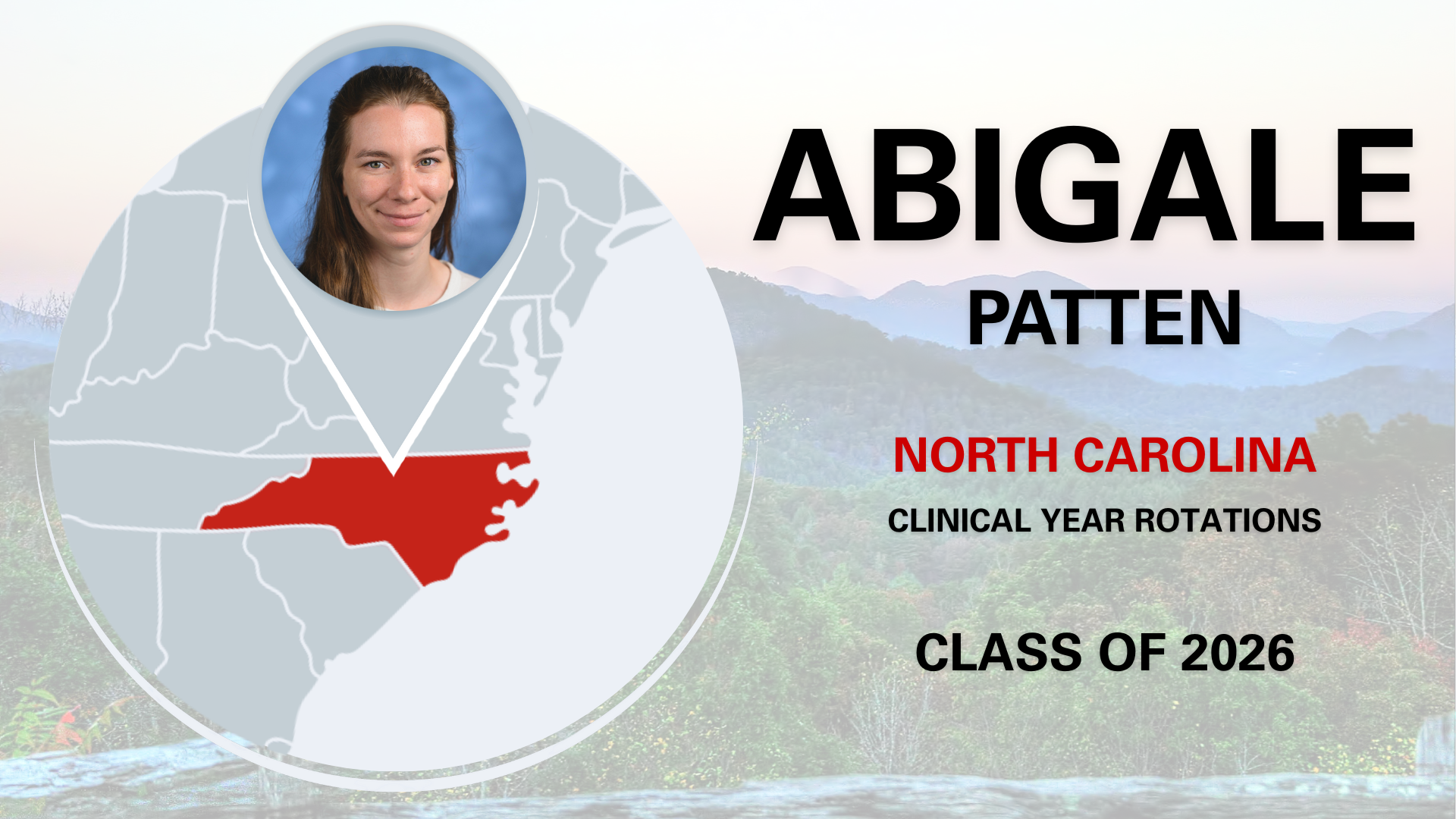From the Rosebud Reservation in South Dakota, Ally Elliott Reports
Students at the NC State College of Veterinary Medicine have access to all kinds of internships, externships and research experiences during their four years of school. This summer, several students are sharing some of what they're doing and learning in real time.
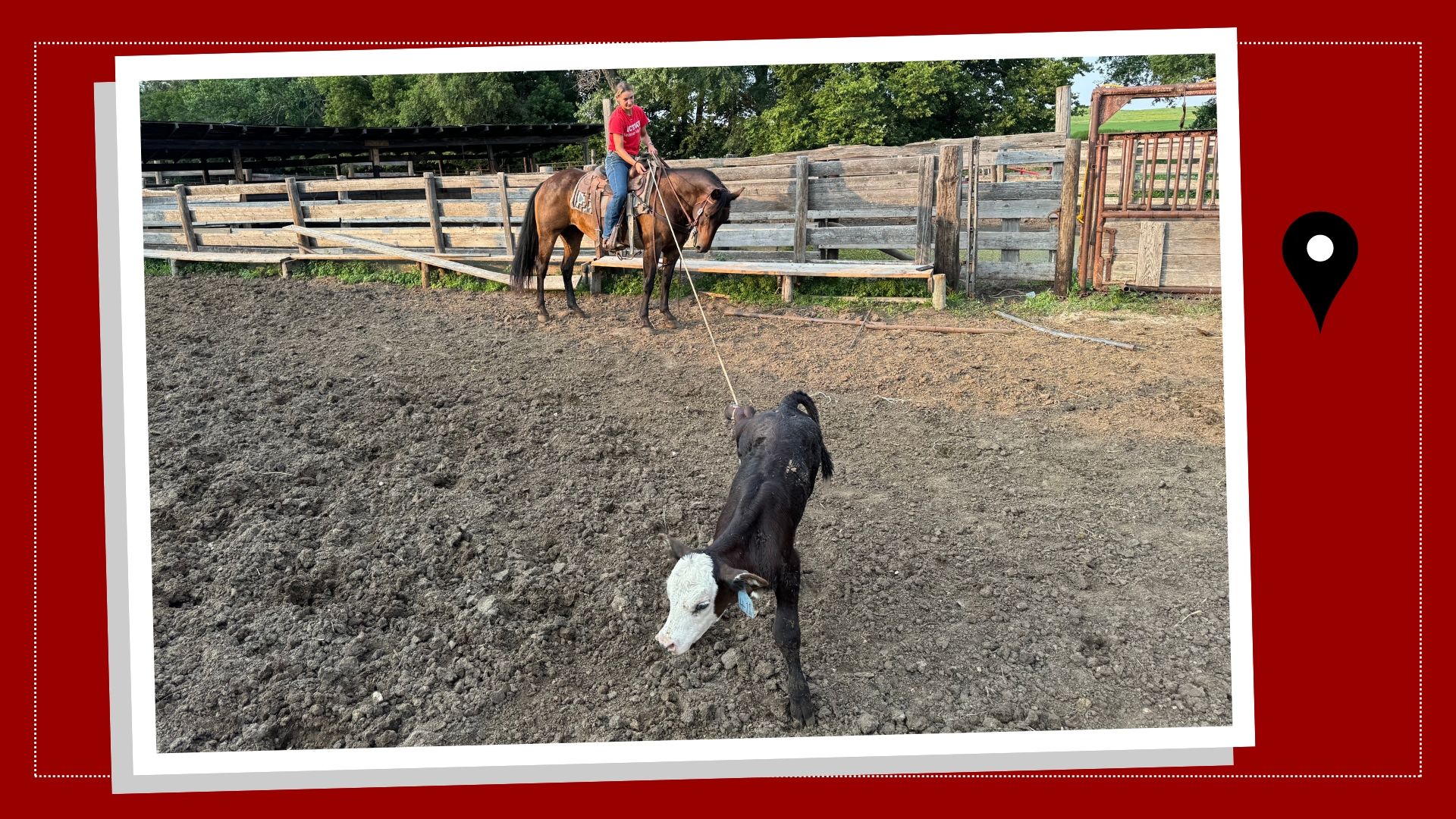
Over the past week, we harvested two bulls in our pasture to give to two Sun Dances in the community. The Sun Dance is one of the most important ceremonies of the Lakota and takes place for four days, without food and water, where dancers male and female converge in the center of the arbor in acts of prayer, renewal and cleansing. We provide buffalo meat, particularly the heart as it is buried under the tree in the center of the arbor, and the rest of the meat is fed to those who come to support and assist in the ceremony. Sun Dance is quite a difficult ceremony to explain and convey its importance and power through words, and I definitely cannot do it justice. But I encourage you to do some research and, if you ever get the opportunity to attend, you shouldn’t pass it up as it is a great honor. This is also a very private ceremony so there are no photos or videos, and the only way to truly experience it is in person.
We were also able to get some drone footage and an accurate calf count, thanks to our media team at Sinte Gleska University. This will help us get a good perspective of our breeding rate. The calves are all looking very strong and healthy, and it appears we had one born last week, which is pretty late in the season for bison.
An update on my rattlesnake-bitten calf: She is doing incredibly well and is healing up better than expected. There is no more necrotic tissue and no signs of infection. It looks as though the wounds are healing quite nicely and filling in with new healthy granulation tissue. While these wounds continue to close, I have been rebandaging and cleaning the wounds every few days as well as giving her banamine for pain and inflammation and continuing her antibiotic course. She is not weight-bearing yet, but with the way things are going I feel within the next few weeks she should be. She has also made good friends with Pepper, and they are two peas in a pod, although I will say Pepper definitely prefers her milk cow over anyone else!
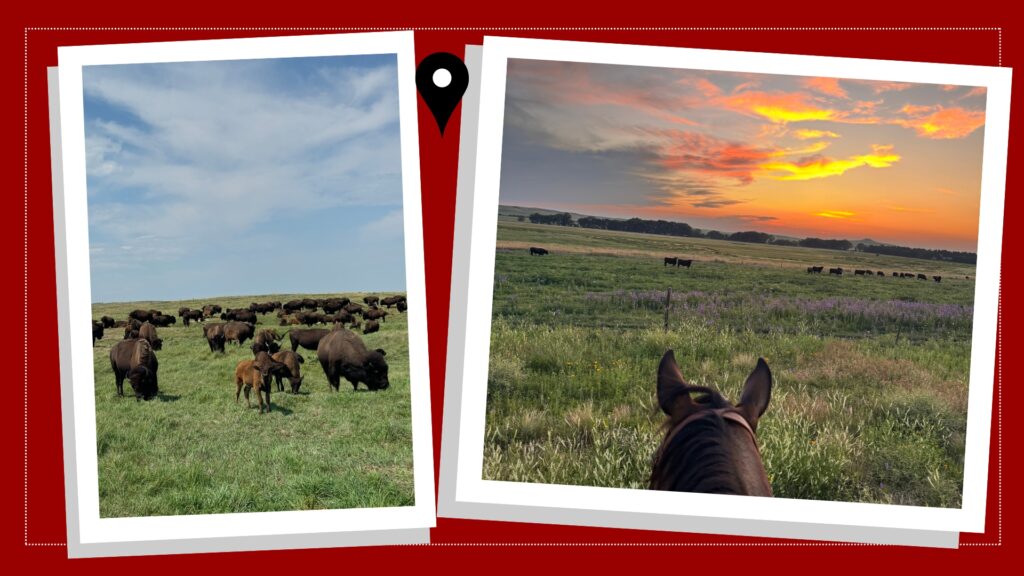
We also had a few late calves to vaccinate and castrate at the Tate Ranch. This meant I got to work on my roping and see how my horse is progressing. My horse, Lula, did great, and I didn’t get bucked off so I would call that a success! We were able to get all the calves safely roped and worked so they are now enjoying their time back in the pasture with their moms!
I take pictures of South Dakota sunsets while I’m out checking pastures. I cannot say this enough, but the sunsets out here are the best in the world, and my pictures never even come close to doing them justice. The beauty of this place is always breathtaking!
JULY 15, 2024
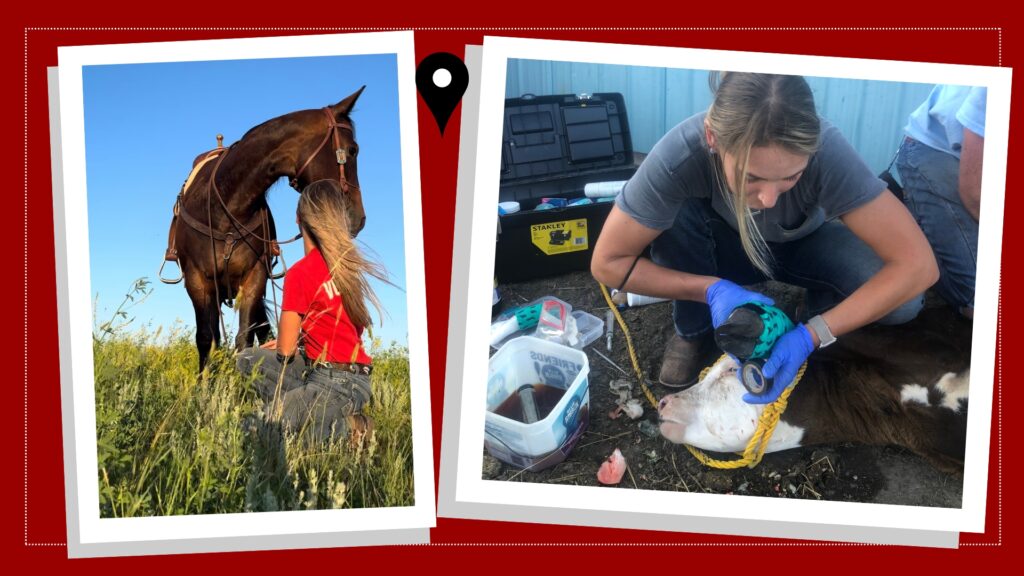
These past few weeks, we have been doing our daily herd and fence checks, and it seems that our girls in the north pasture are quite content with their new additions. The three bulls have been settling in well and have integrated into the herd better than expected.
We are continuing with our rangeland analysis using the Natural Resources Conservation Service. This program provides financial assistance to farmers and ranchers to help them better manage the land, using conservation practices that also increase productivity for the landowners. We took samples of the soil and an inventory of native and invasive plants that make up the pasture. This allows us to determine the nutritional quality of our pasture for the bison as well as the overall health and productivity of the pasture and soil lying beneath. This data will allow us to develop a rotational grazing system that will increase our productivity and better our management of the land itself.
At another ranch where we had doctored a calf for foot rot about a week ago, we went back out to check on her, and her fetlock had swollen to the size of a softball. We got her roped down with mom close by — but not close enough to come after us while we were helping her baby. We realized the calf had two ulceration-type lesions on her fetlock that looked as if they might have come from puncture wounds. Our conclusion was a snake bite, possibly from a rattlesnake because we had found a den close by.
We started flushing and bandaging the wound every day, and we have given antibiotics systemically as well as locally in addition to banamine to help with the pain and swelling. Unfortunately, the infection has infiltrated the joint so this healing process will be much more difficult and lengthy. We hope to eliminate the infection and allow the tissue to heal and close, but this may require sutures once the infection has cleared. This calf most likely will always be lame because the joint is now compromised, but if we’re lucky it will fuse. She might not be the fastest cow, but she will absolutely still be able to get around and will be able to live out the rest of her life happy and healthy.
We had a few days off for the July Fourth holiday, and what better way to spend them than working cattle? I helped a local rancher and friend of mine pair out 40 cow-calf pairs to be shipped back to their owner. This involves riding through the herd and allowing calves to pair up with their moms and then peeling them off the herd to move them into sorting pens. Once we got our 40 pairs, we sorted calves from cows and decided to doctor and vaccinate all of them because it had been quite rainy and cold, and calves in another lot were beginning to show respiratory signs.
We gave a five-way vaccine for respiratory diseases, a seven-way clostridium vaccine as well as Draxxin, a respiratory antibiotic, to all of the calves as preemptive measures. We had a few calves we had to rope and doctor, and my horse is slowly becoming more comfortable with roping and dragging! I’m working with her daily by desensitizing her to the rope being under feet and along her back legs. Although she’s a little fearful, she is trusting me and the process and is making great strides. What more could you ask for!

Given the July Fourth holiday, I couldn’t not mention how much I admire the people I work for out here and what they do for this country as well as the local community.
The people and community here are the backbone of this country working behind the scenes. This is why I love it out here, the culture, the community and the kindness overflow, and there is no one I would rather work for and be able to provide veterinary services and the knowledge that has been given to me than to people like this! I’m forever grateful!
I also couldn’t end without giving a Pepper update! She is getting so big so fast and has developed quite a relationship with the milk cow. She grunts at the gate waiting for her to come in, and the momma will even moo and beller back at her. It’s quite adorable. I’ve been working with her on getting used to the halter so it’s easier to transport her, and she is slowly warming up to it. The leading part, however, is still a challenge. She is still pretty wild, which is good, as we will return her back to the herd when she gets old enough to sustain herself so I do need her to retain some of her wild instincts. Thankfully, though, she does warm up to me with time, and she will lick my arms and even my face when she comes up to me! It’s a slow process, but I think we’re starting to create a little bond.
JULY 5, 2024

This last week was a rather busy one! On Monday we were able to finally put in our three breeding bulls into the north pasture. They ran right out of the trailer and straight for the ladies. Bison have an extremely good sense of smell and can catch scents up to 2 miles away so these boys knew exactly where their females were and where they were headed. The females and their babies greeted them with many grunts and have been pretty content with their new additions this past week.
We also had a rangeland specialist, Lealand Schoon, come in and discuss our options for a soil and pasture analysis as well as rotational grazing plan for the north pasture. This will help us better analyze the quality of hay and forage in the pasture that will sustain our herd. Rotational grazing will allow for better pasture quality and land conservation as well quality nutrition. Land preservation/conservation is one of the founding principles when it comes to tribal values and responsibilities. Without the land, we have nothing, and we are responsible for caring for the land as it has cared for us.
On Wednesday, we had the day off so I went and helped out a local rancher and paired out calves with him. We had one calf with foot rot that I was able to practice my roping skills on and I got him first catch! I caught his head and a leg which is perfect so that way I could pull him without him losing his airway and also keep him stable. I walked my way down the line of the rope and was able to give him a shot of LA 200, which is a tetracycline antibiotic that should clear up his foot rot infection within a few days.
On Friday I was able to ride with Dr. Covey to a local white tail deer breeding farm. The owner gave us a call about a lameness in his main breeding buck, Vesuvius. We were able to dart and sedate him in order to do our exam. Unfortunately, we believed the lameness to be in the shoulder and because this had been going on a while and he had been eating less and less, the prognosis didn’t look great. We gave him a steroid shot to see whether it would help the lameness and if we could manage it with pain medication. We’re hoping for the best and waiting to hear how Vesuvius is doing!
Last but not least is our weekly Pepper, the bison calf, update. She is getting bigger and stronger by the day and unfortunately a bit spicier — haha! She has quite the personality, and we are trying to figure out new ways of gentling her down. She is getting more used to her halter and us petting her, but she has not quite figured out the leading part yet. I got her some peanuts as food motivation as the shells are good for chewing enrichment as well as a good source of fat and protein. The other calves seem to like them and were waiting on the verdict of whether Pepper does, too. She’s quite picky!
JUNE 28, 2024
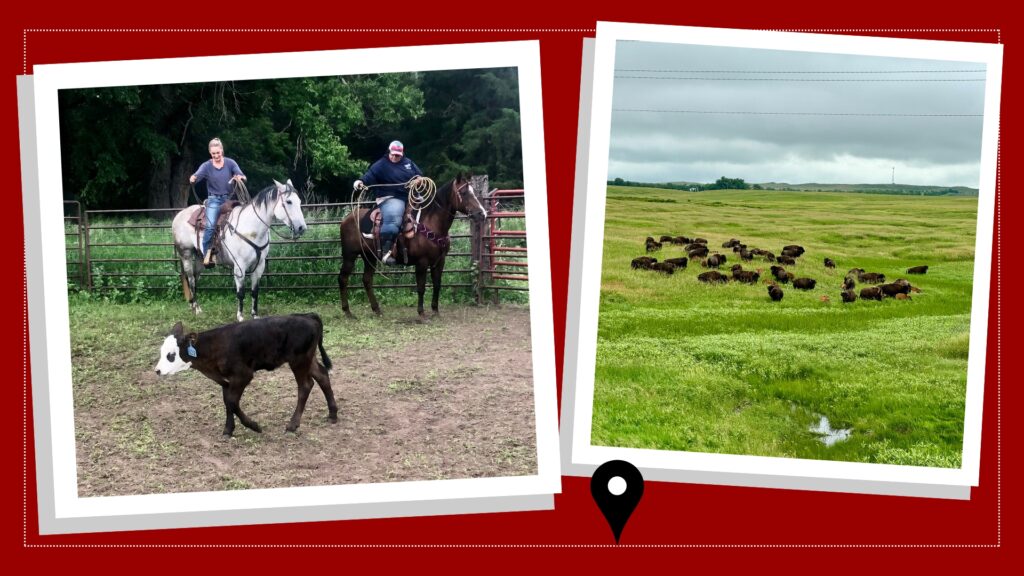
These past two weeks, we have been out checking the herd and getting calf counts to determine our breeding rate thus far. This coming week we are dropping three 2-year-old breeding bulls into the bison herd in the north pasture to better our genetic lineage as well as to increase reproductive productivity.
Pepper, our baby bison calf, is doing really well and has become quite smart. She has now learned how to back herself out of the head gate I was using to help bottle feed her as well as learning how to crawl under fences when she sees the milk cow coming in. She is quite the handful but still adorable and getting bigger by the day. We are working on gentling her down so she is used to us and not frightened when we come into the pen. To desensitize her, we have been petting her and rubbing on her while she is drinking from the milk cow as well as working on making a rope halter for her so we can handle her easier and with less stress.

I also got the opportunity to assist in preg-checking about 45 cows as well as breeding soundness exams on a handful of bulls at the ranch of Duane Tate, who is a wonderful friend of mine. Our breeding soundness exams involve semen testing for motility, sperm count and any defects as well as overall examination of the health of the bull. We actually are keeping Pepper at this ranch, and she has a few other bottle calves in with her as well to keep her company. I help feed them along with her in the afternoons and evenings.
Lastly, we had a late branding of about 45 calves at Duane’s place last week, and I helped to castrate and vaccinate the calves as well as put in a good attempt at roping. It was quite a spectacle, but it is always a great opportunity to learn and work with some really kind and knowledgeable people. The calves are doing well and are out in the pasture with their mommas now.
JUNE 19, 2004
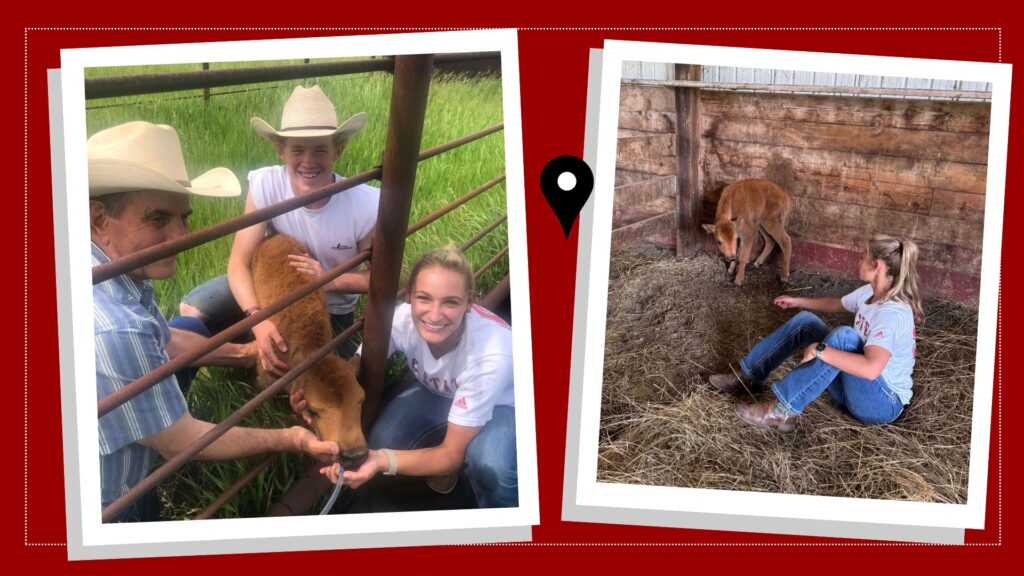
Over the weekend, I got a call that one of our bison calves had wandered to the other side of the fence and lay down in a ditch with mom and the herd nowhere to be found. I had them grab her and put her back into the north pasture near the herd, and we would check on her in the morning, hoping she would pair up with her mom overnight. She was pretty strong and up and walking so it seemed she couldn’t have been away from mom for too long, but she also was only a few days old.
That next morning, we went into the pasture to see whether her mom had paired up with her, and she still was by herself and a ways away from the herd. We tried to push the herd toward her, but there was one bison that was calving so they didn’t want to move as they like to protect each other during calving.
We decided to push the baby toward the herd using side-by-sides and an ATV. We had to push her about a mile or two, and we got her pretty close to the herd but then something spooked them and they ran even farther.
At that point, the baby was getting exhausted and would go only a couple hundred feet and have to lie down. We decided that if she didn’t get milk or electrolytes soon, she might not make it.
We grabbed her then drove her quickly to the corrals. Once we got her in, I was able to tube her with fluids and electrolytes, and she started doing much better almost immediately. We realized she was orphaned so we decided to bottle-feed her until she is old enough to be returned back to the herd.
Currently, we have her at a local rancher’s barn, and he is helping us tremendously as he even got her to take to his milk cow. We use the milk cow and also supplement with milk-replacer bottles as we want her to be a little more tame around us but not so tame that the herd won’t accept her back.
She is slowly warming up to us but is definitely still skittish so we have to take our time and have some patience. We finally came up with a name for her after about a week and landed on Pepper — because she is a bit spicy!
We recently had the Iowa State veterinarians come out for the annual equine clinic on the reservation. I have been able to learn and assist them for the past three or four years, and each year is so much fun.
A huge shoutout to Drs. Callie Felster, Molly Lee, Broch Mauch and Zach Vosburg as well as the techs and students. We all have such a great time each year, and I love being able to show them around the rez and all of the beautiful things, people, and places it has to offer.
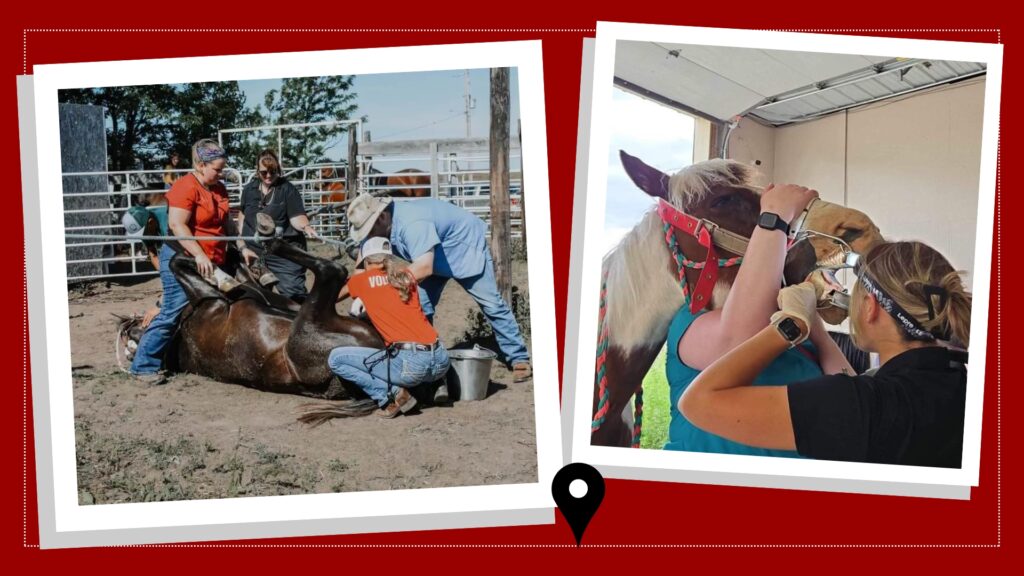
We also started at the Lakota Equine Therapy Ranch and worked on 23 of their horses, providing wellness exams, vaccines and floats. We also saw appointments at Wamakanskan Wawokiye Oti or the Helping Animal Center. Kathleen Woodenknife is the founder of this nonprofit clinic and always had a dream to be able to provide veterinary care for the animals here. On the reservation, access to veterinary care is very limited, and a lot of people just don’t have the funds to take care of the animals they love.
Kathleen, also a tribal council member, has now spent many years trying to make accessible veterinary care a reality and has done such an amazing job in writing grants, organizing vets and working through tribal council. There are now free clinics almost every week for the animals here.
The four-legged play such an integral part of the community and are considered relatives and should be treated as such. More specifically, the Sunkawakan Oyate “horse nation” is part of the DNA of the Lakota, and this can truly be seen in their bond with horses.
When I worked at the equine therapy ranch, we would start each relative, or child, with a Spirit Connection with the horses. Each horse has a story of where it came from as well as past trauma it has been through that led it to the ranch, similar to the children and families in the program.
This ceremony starts by placing the relative in the middle of the arena and running all of the horses around the child one direction and back the other. This mixes up the energies in the arena and then they can focus on just the one child standing in the center. We then step out and allow the horses to move freely, and usually within a few minutes one horse will intently choose that child and walk up to him or her giving the child consent to connect with it.
To complete the ceremony, the relative will then reach out to the horse and hug its neck and halter the horse as this begins their relationship for that semester of therapy. Usually, the horse that chooses the child tends to have a similar story in the trauma it has experienced as well as similar personalities. You will see throughout the sessions how they both help each other to heal from these past hurts. It is hard to put into words the energy and emotion you feel during this connection, but it is almost palpable.
This is why it is so important to have accessible veterinary care in this community because the horse nation is at the center of their culture. With everyone’s help, we were able to do 120 wellness exams, 20 dentals and even 16 castrations in just 2.5 days! Woplia “thank you” to everyone who helped get this done including doctors, techs, students and community members!
Earlier in the week, I was invited to a few brandings to vaccinate and castrate cattle as well as help with their cattle drives. The first drive we took them about 10 miles north and across the highway, and thankfully everything went really smoothly. We had a bunch of help and enough riders to help push and guide the cattle safely.

The second drive of the day was a short one, but we noticed a calf was lagging behind. After closer examination, we realized he had some swelling in his abdomen so we roped him and got him tied down and secured. We realized that his castration had not left a large enough hole to drain so we made a larger incision and continued to examine him.
Unfortunately, since the branding was the day before, it was likely the spermatic cord had retracted back into the abdomen. Thankfully, I had invited one of the new vets in the area to help us move cattle as she had a young horse she wanted to put miles on. She and I tried to find the cord, but after about an hour with not much equipment to help us in the field, we decided to sew him back up and give him some pain meds and antibiotics. A trip to the clinic was too great an expense for this rancher so we did the best we could with what we had. In ranching, they want the best for their animals but also have to take into consideration their profit-loss margin, which in ranching can be extremely narrow.
Shockingly, the calf made it through the evening and even to the next morning and was up and drinking. The swelling had gone down, and his abdomen was only slightly distended. We had the rancher trailer him to where we had more supplies that next afternoon. We sedated him with xylazine, flushed out the incision and cavity with iodine and water and sutured the inguinal ring and skin closed. We gave him antibiotics and pain meds to take home, and we’re hoping for the best. I’ve got word from the rancher that he is doing much better!
June 10, 2024
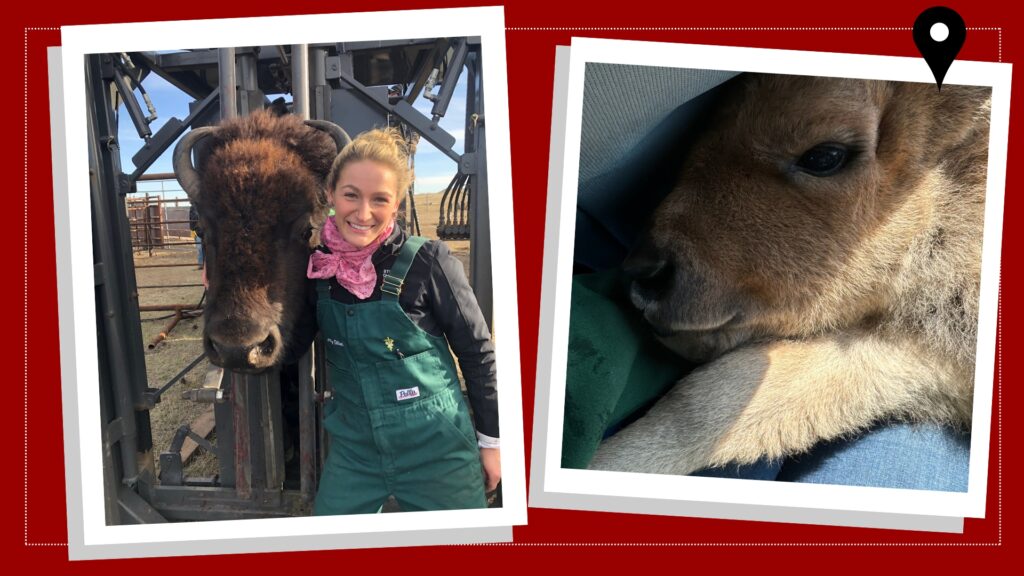
Hi, my name is Ally Elliott, and I’m a third-year vet student with a food animal focus. Last year I was presented with an opportunity and a grant for four years from the Rosebud Sioux Tribe’s Sinte Gleska University to aid in herd health management practices and veterinary consulting for their bison herd.
Before veterinary school, I worked at Tiwahe Glu Kini Pi (“bringing the family back together” in Lakota) as a horse handler for their Lakota equine therapy program in which they assist children and families in the mental health field on the reservation. I’m so grateful for the friends and family I have made out here throughout the years who have been kind enough to share their cultural wisdom and kindness with me. Living on the Rosebud Reservation and learning the culture and way of life of the Lakota have been some of the most valuable experiences of my life, and I use these lessons and stories in my day to day life and practice.
The bison project is run by Shawn Bordeaux, a South Dakota state senator, Steve Her Many Horses and Dave Blue Thunder. Since last summer, we have been able to downsize the bison herd to a more manageable population for the land as well as vaccinate, deworm, tag and create a full inventory for both our north and south pastures. I was also fortunate enough to have a good friend of mine and teacher, Hillary Sherwood, bring out her student, Kaden Leader Charge, to teach him alongside us. I’m always so grateful to have these experiences where I can give back and share the knowledge that has been passed down to me. Kaden was super excited and really passionate as well as a great helper in the whole process. I see him being very successful in the animal world one day!

Working the herd this past November has aided us in becoming a more sustainable and healthy herd, and the goal is to create a productive cow calf operation that is self-sufficient as well as coincides with the cultural aspects of the way the Lakota honor the bison. Bison are an integral part of Lakota history and culture. Many values and ways of life stem from the way of the bison. They are honored and revered, and before harvesting and working the herd we honor them with a prayer and offer tobacco to give back to the land and thank the bison for all that they provide for us.
During a recent week on the reservation, I was able to work with Dr. Tom Covey to aid in breeding soundness exams on another prominent bison herd here. We also had a bison calf born with knuckling fetlocks in our own pasture this week. We loaded him up in the truck and drove him 40 miles east to the clinic. When we found him in the pasture, he was unable to stand and was very dehydrated. His heart and respiration rates were very elevated, but this was also exacerbated due to the stress of the drive and handling.
Unfortunately, by the time we got to the clinic and got an IV in him, he could not hold on any longer. We named him Hoksila “boy” before he passed as this would give him a name in his life thereafter. After he passed, we analyzed what could have happened. We suspect he tried to nurse for a day or two as his fetlocks had no fur and were worn down to the skin from his attempting to stand and walk. After a few days, he just did not have the energy to continue nursing, which led to his not having enough nutrients. He became extremely dehydrated and his blood pressure plummeted. We took him back to the pasture and buried him, said a prayer and gave tobacco for his life and to honor him.
Currently, I am working on procuring a pasture and land analysis for the north and south pastures. With this information, we can partition the land and set up a rotational grazing program to better care for the land and the animals living on it. We are meeting with a USDA liaison because there is a Conservation Reserve Enhancement Program (CREP) to aid us in having a rangeland specialist come out. This program is offered only to three tribes and can help us with money and with developing better conservation practices. These practices are important and significant not only for herd health management but culturally as well.
I also was able to assist with testing out new bucking horses for a friend of mine. They are stock contractors and run their bucking stock called Yellow Hawk Stock Contractors. The bucking horses have been bred specifically for this purpose, and their genetic lineage is pretty prominent in the rodeo world. They supply their stock to Cheyenne Frontier Days, and some of their stock have made it to the Indian National Finals Rodeo.

- Categories:


